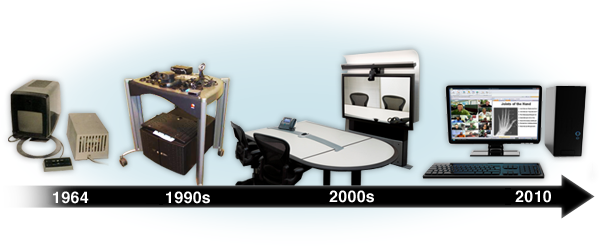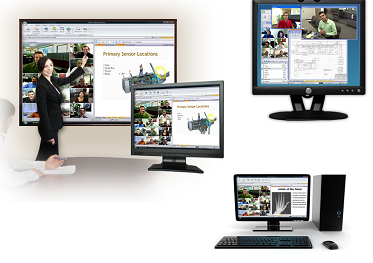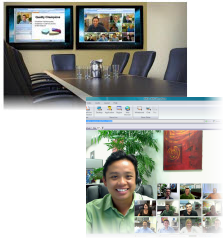
The following commentary is provided
by Nefsis regarding the history of video conferencing and the general
outlook for video conferencing technology in business
communications.
Timeline
Any new invention, or technology for that matter, must prove its usefulness,
cost-effectiveness and solve a problem that warrants its existence. Video
conferencing provides us with a solid history lesson in a technology that has
had many starts, stops and stalls along the way to becoming a commonplace
real-time communication system used throughout most industries, the government,
the military and schools around the world.
Along with the invention of the television came the ability to conduct simple
analog conferencing. It was a very simple system that consisted of two closed
circuit television systems connected by cable. In fact, NASA used two
radiofrequency UHF or VHF links, in both directions. Even today, television
stations frequently use this type of video conferencing to report live from
distant locations.
When video conferencing was first introduced, with a grand introduction at the
1964 World's Fair held in New York, it had a futuristic quality that no one
could possibly dream would take the place of the standard telephone. Though AT&T
introduced the Picturephone many years later in 1970, it was still impractical
and expensive when first offered to consumers ($160/month for each fixed
end-point).
It wasn't until Ericsson demonstrated the very first trans-Atlantic LME video
telephone call that companies saw the real potential for success and
profitability and began to refine their own video conferencing technologies.
Advancements such as Network Video Protocol (NVP), in 1976, and the Packet Video
Protocol (PVP), in 1981, both helped the maturation of video conferencing, but
both stayed in the laboratory or for private corporate usage.
Even before that, Nippon Telegraph and Telephone established video conferencing
between Tokyo and Osaka in 1976. In 1982, IBM Japan took video conferencing (VC)
one-step further and established a 48,000 bps to link up with IBM's internal
video conferencing links in the U.S. for weekly business meetings.
The 1980s Bring Video Conferencing to the Commercial Market
When VC finally did hit the commercial market, it was extremely expensive, too
expensive to make widespread adoption possible. Compression Labs introduced
their VC product in 1982 for $250,000 that had lines that cost $1,000 per hour.
The system required vast resources that were capable of tripping 15 amp circuit
breakers. It was the only working video conferencing system available until
PictureTel introduced their VC offering in 1986 and in just four years time the
price had dropped dramatically at $80,000 with a $100 per hour line fee.
In between these two landmark systems that helped further the development of
video conferencing systems, software and technology, there were other VC systems
that were designed for in-house use by several corporations and also the U.S.
military. In the early to mid-1980s, Datapoint was utilizing the Datapoint MINX
system on their Texas campus, which they also sold to the military.
Of course video conferencing history has had its share of flops because it had
not yet been embraced by consumers or by business. In the late 1980s, Mitsubishi
began selling a still-picture phone. One can only imagine the cost of product
design and development of this picture-phone; nevertheless, Mitsubishi dropped
the line just two years after introducing it.
The 1990s saw the advancement and development of video conferencing systems due
to many factors, including technical advances in Internet Protocol (IP) and also
more efficient video compression technologies were developed that would permit
desktop or PC-based videoconferencing. In 1991, IBM introduced the first
PC-based video conferencing system, named PicTel. Although it was a black and
white system that was very inexpensive, costing only $30 per line, per hour, the
system itself cost $20,000. Not much later in 1991, DARTnet made video
conferencing history by successfully connecting a transcontinental IP network
consisting of more than 12 research sites in the U.S. and the U.K. using T1
trunks. DARTnet, now known as the CAIRN system, still exists today and connects
dozens of institutions.
It wasn't long after that VC started infiltrating the masses through free
services and software, such as NetMeeting, MSN Messenger, and Yahoo Messenger,
to name a few. While the video quality was poor at best, the price was right and
slowly it started to be adopted by the consumer market. It was now only a matter
of time before video conferencing made its way to corporate desktops around the
world.
The CU-SeeMe Revolution
One of the VC systems that would make history and dramatically impacted the
future of commercial video conferencing is CU-SeeMe, which ran on the Apple
Macintosh and became available to the public in 1992. Even though it lacked
audio, it was by far the best video system developed to date. CU-SeeMe rapidly
progressed and by 1993 it had multipoint capability and in 1994 added audio to
its list of features. Early on, the limitations of CU-SeeMe for Mac in a mostly
PC world were recognized and its developers quickly began working on a
Windows-compatible version. In 1994, Windows-based CU-SeeMe was launched and in
1995, CU-SeeMe v0.66b1 complete with audio followed. While CU-SeeMe was popular,
its combination of [UDP] broadcasting and peer-to-peer connection methodology
limited applications to school rooms and training facilities with all users on
the same network (with no intervening firewalls or network address translators).
In parallel with CU-SeeMe, AT&T targeted consumers in 1992 with its $1,500
videophone. It was moderately successful. There were at least two other firsts
in 1992, a combined audio and video broadcast took place utilizing the MBone
system and in July of the same year INRIA introduced their VC system. This is
the first year that real traction was taking place in the video conferencing
market and this momentum prompted the quiet development and ratification of
compatibility standards by the International Telecommunications Union (ITU).
ITU Standards Set the Pace for Video Conferencing
A combination of specifications and standards paved the way for video
conferencing as an application to be taken seriously in the business world. The
ITU established the Standard H.263, which reduced bandwidth transmission for low
bit-rate communications. Other standards were already in development, such as
H.323 for packet-based multimedia applications, both H.263 and H.323 among other
standards were revised and updated in 1998. The Moving Picture Experts Group
developed MPEG-4 as an ISO standard for multimedia content and while not
directly related to video conferencing as a desktop application, all standards
previously mentioned worked together to further advance the concept of
interoperability with regard to data content and its transmission.
Still, there were setbacks and some companies failed in their attempts at
success in the video conferencing market. VocalChat Novell IPX Networks
introduced their first video conferencing system but it never found a market
niche and it failed commercially. Microsoft entered the video conferencing
market in August 1996, with NetMeeting, which was a descendent of PictureTel's
Liveshare Plus, but it didn't have video capabilities initially. In December of
1996, Microsoft introduced NetMeeting v2.0b2 with video. While NetMeeting had,
and still has its disadvantages, it definitely set the stage and raised the bar
for new entrants into the video conferencing market at the same time.
Caltech-CERN Project Connects Research Centers Around the World
The Caltech-CERN project, also known as the Virtual Room Videoconferencing
System (VRVS), officially launched in July 1997. Caltech-CERN researchers
initially developed VRVS to provide researchers and scientists with a means to
videoconference and collaborate on the Large Hadron Collider Project and in the
U.S. and European High Energy and Nuclear Physics communities. It was extremely
successful. So much so, that seed money was raised for Phase Two, CalREN-2,
which would expand and improve on the VRVS system. The expansion would make VRVS
available to geneticists, doctors and other scientists around the globe.
Cornell University's development team released CU-SeeMe 1.0 in 1998. Version 1.0
not only supported both the Mac and the PC, but it featured color video —
this was a huge leap for desktop video conferencing in terms of feature
functionality and broadened the market for CU-SeeMe considerably.
In the meantime, groups were busy developing standards that could only help
further video conferencing as a business communication technology. Session
Initiation Protocol (SIP) was officially announced by MMUSIC in 1999. SIP proved
to have some user-related advantages not found in H.323 that helped it gain a
fair share of supporters, including Microsoft eventually. There was plenty of
activity from standards committees and vendors alike in 1999. NetMeeting v3.0b
came out with Version 3.0 of the ITU standard H.323 followed by the first
version of the Media Gateway Control Protocol (MGCP). Later in the year, ISO
standard MPEG-4 version two was released and PSInet became the first company
to rollout automated multipoint services based on the H.323 standard.
While relatively young, SIP continued to develop and evolve as it entered
version 1.30 in November of 2000. Following that, the fourth version of H.323
was released. In conjunction with developments in the video conferencing
space, wireless mobile phone manufacturers started competing vigorously
for their fair share of the consumer market. Realizing that video could
indeed be the future, and a goldmine for makers of digital mobile phones,
Samsung released their MPEG-4 streaming 3G video mobile phone, the very
first on the shelves and a particularly huge success in Japan.
Microsoft made a bold move by announcing in 2001 that its Windows XP Messenger
would support SIP. It was also the year that video conferencing was getting
attention from vertical industries that saw its potential. The first
transatlantic "telesurgery", with video conferencing center stage, took place
allowing a surgeon in the U.S. to control a robot overseas to perform gall
bladder surgery. To date it was the most compelling, non-business use of video
conferencing and indeed brought VC to the attention of medical practitioners and
the general public throughout the world.
Not long after the "War on Terror" commenced, TV reporters used a portable
satellite and a videophone to broadcast live from Afghanistan in October 2001.
It was the first time that video conferencing technology was used to talk in
real-time with someone in the war zone via video. For the first time, war was
being broadcast in real-time to people around the world rather than by taped
broadcast.
By the end of 2002, the Joint Video Team finished research that led to the ITU-T
H.264 protocol. This protocol standardized video compression technology for both
MPEG-4 and ITU-T for a wide range of application areas. It was much more
versatile than preceding protocols. The new technology would be ready for its
introduction to the video industry in March 2004.
Video Conferencing Evolves
 By
2003, high-speed Internet access became widely available at a very reasonable
cost. At the same time, the cost of video capture and display technology also
decreased. The general public was able to afford web cameras, the cost of PCs at
the time was minimal and broadband Internet access was available in nearly every
region of the country. All of these factors, including the availability of free
software from leading IM service providers, combine to make video conferencing
even more accessible for the consumer market.
By
2003, high-speed Internet access became widely available at a very reasonable
cost. At the same time, the cost of video capture and display technology also
decreased. The general public was able to afford web cameras, the cost of PCs at
the time was minimal and broadband Internet access was available in nearly every
region of the country. All of these factors, including the availability of free
software from leading IM service providers, combine to make video conferencing
even more accessible for the consumer market.
Higher education started to embrace the benefits of video conferencing in 2003.
Schools around the world began to integrate video conferencing into their
distance learning programs to enhance classes with more interactive
classroom-like environments. As the quality of streaming video increased, with
disruptive streaming delays decreased, video conferencing became much more
popular to schools. Administrators and teachers alike realized the immense
benefits of real-time interaction between professors and students. VBrick began
providing various MPEG-4 video systems to universities in the U.S. and desktop
video was rapidly gaining favor and popularity as an effective means to
communicate and interact in real-time for business organizations throughout
the country.
In 2004, video conferencing companies continued refining their applications
and fine-tune it for more reliable performance and usability. In March 2004,
a Linux-based free video conferencing platform that is H.323 compliant and
NetMeeting-compatible was released. In April of the same year, Applied Global
Technologies developed a web camera that when used in conjunction with video,
tracks the voice of the speaker in order to focus on whomever is speaking at
the time.
Later in 2004, WiredRed Software became the first company to
incorporate multipoint
video as a standard feature in a
web conferencing solution. This marked the beginning of web
conferencing software products incorporating video features and
overlapping with the video conferencing industry. In March 2005,
WiredRed made another first by offering web, VoIP and video conferencing
over secure connections that can utilize third-party, or on-premise
public key infrastructure (PKI) systems.
In 2008, WiredRed introduced a cloud-based, online service version of
its software products under the Nefsis brand name. Cloud computing
made its debut in the video conferencing industry (Nefsis
timeline). By 2009, the Nefsis product incorporated software-based
echo cancellation (AEC) for voice over Internet conferencing and
more sophisticated collaboration
tools such as annotation over live application sharing and
playing
movie files during a video conference, among other new features.
Present day, Nefsis can deliver virtually unlimited multipoint HD video
conferencing with live collaboration tools via the cloud. Virtually anyone
with a personal computer or conference room PC and standard Internet
access can utilize Nefsis video conferencing.
Proprietary Hardware vs. Cloud-Based Delivery

With the advancement of software technologies, PC processor speeds and
broadband Internet connectivity, it is now possible to rely entirely on
standard PC servers and desktops to accomplish boardroom-quality video
conferencing. However, hardware-based systems are still available today.
Dedicated video conferencing systems generally have all required components
in a single piece of equipment. Usually this is a console with a high quality
video camera that is controlled remotely. These cameras, also known as PTZ
cameras, can be controlled from a distance to pan left, tilt up and down,
and zoom. The console itself contains all electrical interfaces, the control
computer and the software or hardware-based itself. Omni directional microphones,
a TV monitor with speakers and/or video projector are connected to the
console.
There are several types of dedicated video conferencing devices that range
in price and quality:
- Individual devices are usually portable and meant for single users.
It has fixed cameras, microphones and loudspeakers integrated into the console.
- Desktop systems are usually manufactured by integrating add-on boards to
standard PCs. A variety of cameras and microphones can be used with the board,
which contains the necessary codec and transmission interfaces. Most of the
desktop systems support the H.323 standard.
- Large group systems are expensive, non-portable devices used in one-way type
seminars in large rooms and auditoriums.
- Small group systems can be non-portable or portable. This type of system is
smaller and a less expensive device used in small meeting applications.
The history of video conferencing, although always a work in process,
illustrates just how far the technology has come since its debut in 1964.
It has clearly broken through nearly every roadblock it has faced and is
still in a state of growth and transition.
Video conferencing will continue to evolve until it becomes an
integral part of business and personal life. As the technology undergoes
further transformation, it will undoubtedly become more affordable and
eventually ubiquitous.
Contact the Sponsor:
Nefsis Video Conferencing Home Page
 For
business readers and IT staff, we welcome you to contact us, or
schedule a live demo to
see the latest in scalable video technology.
For
business readers and IT staff, we welcome you to contact us, or
schedule a live demo to
see the latest in scalable video technology.
The Nefsis cloud-based approach provides HD quality,
supports desktops and multipurpose conference rooms, and comes
with a full suite of built-in web collaboration tools. Moreover,
the cloud-based approach is far less expensive, more flexible,
and easier to expand the pre-Internet video conferencing
architectures that required complex equipment, MCUs,
collaboration add-ons and desktop gateway servers.

